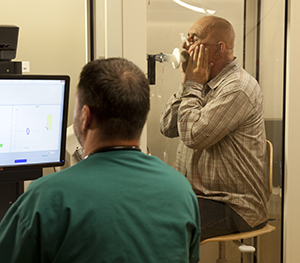Diagnosing Interstitial Lung Disease
When you have interstitial lung disease, your lungs become scarred. This makes it hard for you to breathe. To diagnose interstitial lung disease, your healthcare provider needs to know about your job, lifestyle, and symptoms. Your provider will listen to your lungs and heart and look at your nose and throat. You may also need tests.
Your health history
You may be asked some of these questions:
-
Do you have shortness of breath?
-
What medicines do you take?
-
Have you breathed in any harmful substances over a long period of time? This could include molds, chemicals, asbestos, silica, or coal dust.
-
Do you smoke or live with a person who smokes?
-
Have you had radiation therapy? This could be to treat breast cancer, for example.
-
Have you had lung infections?
-
Is there a family history of lung disease or connective tissue disorders?
Tests
You may need routine blood tests and a chest X-ray. Other tests may include:
-
ECG (electrocardiogram). This test checks your heart rhythm. It helps rule out heart disease as the cause of your shortness of breath.
-
CT scan. This test makes a more detailed X-ray image of your lungs.
-
Pulse oximetry. This test uses a small device placed on a fingertip. It measures the oxygen level in your blood at rest and with exercise.
-
Arterial blood gas. This test measures the level of oxygen in your blood. The healthcare provider takes a blood sample from an artery, often at your wrist.
-
Cardiopulmonary stress test. This test checks how well your heart and lungs work when you are active. You often ride a stationary bike or walk on a treadmill.
-
Bronchoscopy. This test allows the healthcare provider to look inside your airways with a thin, lighted tube with a camera on the end (bronchoscope). The bronchoscope is passed through your mouth and throat and into your lungs. The provider may pass tools through the bronchoscope to remove small samples of your lung tissue. This is called a biopsy. The tissue samples can help check for damage or inflammation in your lungs.
-
Surgical lung biopsy. This test removes samples of your lung tissue through 1 or more cuts (incisions) made between your ribs or chest. The tissue samples are often larger than those taken with bronchoscopy. They may provide a more accurate diagnosis of your lung problem.
Pulmonary function tests (PFTs)

PFTs are done in the healthcare provider’s office or in the hospital lab. You may be tested both before and after taking medicine. You may have to repeat the tests from time to time during your treatment. Your healthcare provider may order:
-
Spirometry. This test measures how much air you can breathe out after a deep breath (forced vital capacity). The test also measures how much air you can breathe out in 1 second after a deep breath. This is called forced expiratory volume in 1 second.
-
Lung volume tests. These measure how much air you inhale and how much air is left in your lungs after you exhale.
-
Lung diffusion test. This estimates how much oxygen is transported from the tiny air sacs in your lungs (alveoli) to your blood.
-
6-minute walk test. This test measures the distance you can walk in 6 minutes. The provider will also check your oxygen levels.
Your provider will review all test results with you. They'll also tell you what the next steps will be.
© 2000-2024 The StayWell Company, LLC. All rights reserved. This information is not intended as a substitute for professional medical care. Always follow your healthcare professional's instructions.